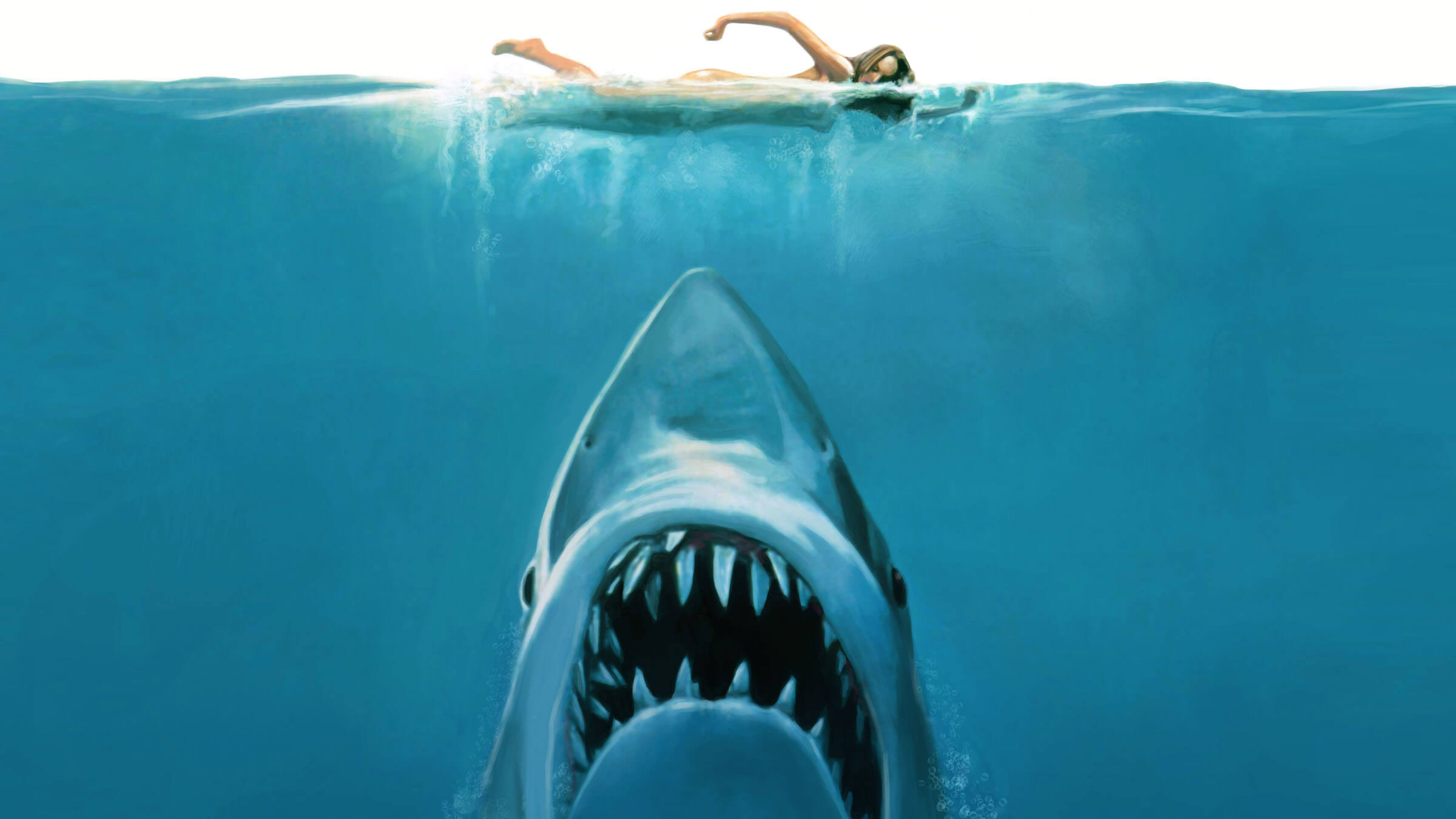Some film trends never go out of style, and for over four decades, the ominous image of a fin circling in the water has been synonymous with terror on the big screen. While sharks are far from the monstrous killers they’re made out to be, in cinema they have become the ruthless, snarling predators of the sea. Over time, the power of that reputation has been used by film-makers in various ways, for various purposes – but almost always leaving you with a fear of stepping into the ocean.
Normally such a long-lasting trend begins with a group of successful hits, but in this case it was all thanks to one legendary blockbuster…
Jaws (1975)
It’s reasonable to assume that, had Steven Spielberg not created this masterpiece of cinema, you wouldn’t be reading this piece – because no one would be interested in shark movies. Not only did Jaws create the formula for every shark movie that followed, it also changed the way we watched cinema, inventing the idea of a summer blockbuster (up until then, big-budget films were often released in the winter). The shark itself was sparingly used, with John Williams’ incredible score and some quick cuts creating a terrifying image in viewers’ minds. Our relationship with sharks would never be the same again.
L’ultimo squalo (aka Great White, 1981)
With success comes imitators, and Jaws had many films trying to cash in on the shark movie craze in the following years – none more so than this Italian-made thriller, which enjoyed much success in America and Europe, in spite of (or perhaps because of) a remarkable similarity to Spielberg’s film. The matter resulted in a court case, which the film-makers eventually lost, leading to the film being pulled from US cinemas. Banned films only gain more mystique, however, and this led to Great White gaining something of a cult status among “bad movie” aficionados.
The Jaws Sequels (1978-87)
While rival films nipped at Jaws’ success, it was the official sequels that would eventually tarnish the shark movie for a decade after. Part of a number of cheap, inferior sequels that blighted the ‘80s, Jaws 2 retained some of the original cast, but little of the genius. Jaws 3D and Jaws: The Return, however, were complete messes that strayed very far from the first film’s brilliance. Perhaps their most lasting legacy is the famous taglines “just when you thought it was safe to go back in the water” (Jaws 2) and “This time, it’s personal” (Jaws: The Revenge).
Deep Blue Sea (1999)
After three Jaws sequels and countless rip-offs, sharks were relatively absent from ‘90s cinema until this thriller introduced the idea of a CGI shark. Mixing modern technology with traditional cinema methods brought to life the story of genetically modified sharks hunting down a group of scientists. While the plot is a little wacky, the fact that the sharks themselves were more believable than in the past made this an outlandish hit, bringing screams back to a genre that had previously elicited yawns. It also features one of the greatest surprise deaths of all time!
Open Water (2003)
What’s scarier than a computer-animated shark? One that you can’t see, but know is there. This tense experience, following two scuba divers stranded in shark-infested waters, plays on the now-culturally established fear of sharks that Jaws created: the idea that they are out there, somewhere beneath the surface, and could drag you down at any moment. The film is a sensory journey that’s almost traumatic to experience, with a loose connection to real-life events tricking you into believing this could actually happen. Not bad for a film that cost less than the shark in Jaws!
Shark Tale (2004)
A rare attempt to bring a lighter side to the underwater villain, Dreamworks Animation subverted the idea of the scary shark in a family comedy about a quick-thinking, ambitious fish (Will Smith) who poses as a “shark slayer” with the help of a decidedly unthreatening shark (Jack Black). Feeling like a limp imitation of previous hits like Shrek, it’s best known for a jaw-dropping voice cast that included Angelina Jolie, Robert De Niro and Martin Scorsese. A worthy mention should also go to Bruce, the much funnier shark who makes a brief appearance in Pixar’s Finding Nemo.
Mega Shark vs Giant Octopus (2009)
With the advent of computer animation, shark movies were not the colossal endeavour they once were, and so they became the subject of many parodies and B-movies that came under the banner of “so bad, it’s good”. One of the breakthrough titles was Mega Shark vs Giant Octopus, a ludicrous film that leaned on its far-fetched concept to pastiche the monster movies of the past for an audience hungry for trashier fare to either laugh or groan at. The Mega Shark franchise spawned several sequels, where the titular character fought a Crocosaurus, Mecha Shark and a Kolossus (no, we aren’t sure what they are, either).
Sharknado (2013)
No parody, however, could compare to the cultural phenomenon of Sharknado. Initially a low-budget, intentionally ridiculous TV movie, the film (which, as you might imagine, is about a tornado of sharks) became an enormous hit in the age of Twitter, with people creating a communal viewing experience that has seen this ‘disasterpiece’ compared to films like The Room. While it may not add much to the creative conversation, this and the five sequels that followed proved sharks can still draw an audience!
The Shallows (2016)
Another film that revels in the psychological power of sharks on screen, rather than its imposing physical presence. A lone surfer (Blake Lively) survives a brutal shark attack and becomes stranded tantalisingly close to shore, but the shark blocks her route to safety. Using elements of “found footage” horror and a strong solo performance from Lively (alongside a bird she names Steven Seagull), it’s a modern take on a well-trodden genre that proves you don’t necessarily need a large production to bring about genuine scares. While sharks had been a source of fun in some areas, they still retained their mystique in the horror genre.
47 Meters Down (2017)
Isolation was also a factor in this British-made horror, starring Mandy Moore and Claire Holt as tourists stuck on the ocean floor when the rope to their shark cage breaks. Whereas most films bring sharks to the surface or overlapping territory such as a beach, this film puts our heroes (or victims?) in the sharks’ home territory, adding survival terror to the threat of being attacked. While few films in the Shark Movie genre can be praised for their artistic merit, this and other films show that it’s an area of film-making that’s capable of doing a lot with very little.
The Meg (2018)
With a budget of $150 million, this all-action adaptation of Steve Alten’s novel marries blockbuster spectacle with well-timed thrills, creating one of the most anticipated movies of the year. While a 29-metre CGI mega shark doesn’t leave much room for subtlety, filmmaker Jon Turteltaub works with the huge size of the title character and combines that with a deep underwater setting, where The Meg can emerge from the shadows to terrorise a group of scientists. It’s an all-star combination of 40 years of influences, ranging from Spielberg’s Oscar-winning Jaws to the low-intelligence but highly enjoyable B-movies of the last few years.














Sorry, the comment form is closed at this time.